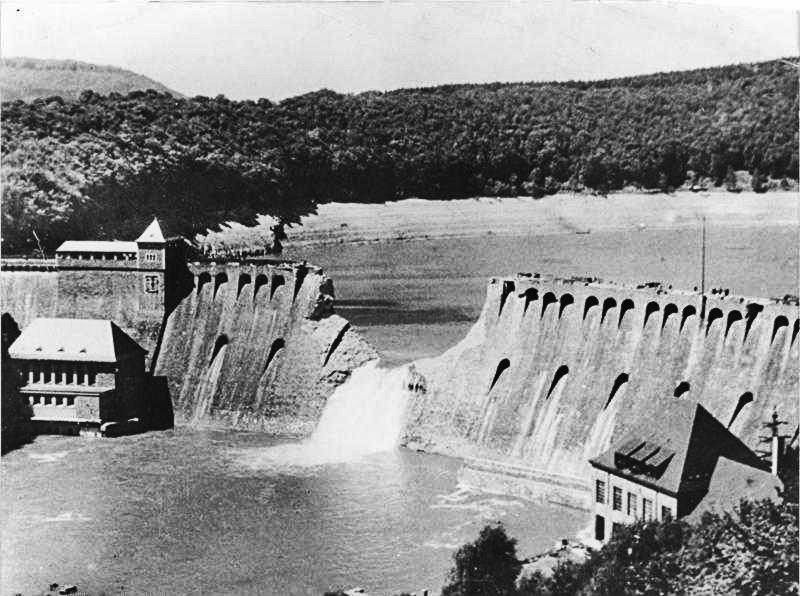 Eder Dam on 17 May 1943. Bundesarchiv, Bild 183-C0212-0043-012 / CC-BY-SA 3.0, via Wikimedia Commons
Eder Dam on 17 May 1943. Bundesarchiv, Bild 183-C0212-0043-012 / CC-BY-SA 3.0, via Wikimedia Commons
Mickey Z. -- World News Trust
March 6, 2016
The title of a March 3, 2016, article definitely baited me to click: “1.5 Million May Die if Mosul Dam Fails: Iraq Expert.” From that article:
“The
U.S. Embassy in Baghdad said a collapse of the dam in the north of
country would be ‘serious and unprecedented.’ Some 500,000 and 1.47
million Iraqis would ‘probably would not survive’ the wave, while water
could reach depths of 45 feet in the nearby city of Mosul, it said in a
statement.”
Even a skeptic
could easily imagine how Iraq’s failing infrastructure included its
dams. But what if I reminded you that Mosul is an ISIS stronghold? And
what if I added that U.S. and Iraqi forces have been planning a massive
joint attack on ISIS in Mosul?
Before you answer those two questions, let’s learn a little about dams.
Dam Nation
The U.S. government tells us:
“Dams provide a range of economic, environmental, and social benefits,
including recreation, flood control, water supply, hydroelectric power,
waste management, river navigation, and wildlife habitat.”
But Jacques Leslie, author of Deep Water: The Epic Struggle over Dams, Displaced People, and the Environment,
paints a different picture: “The world's dams have shifted so much
weight that geophysicists believe they have slightly altered the speed
of the earth's rotation, the tilt of its axis, and the shape of its
gravitational field.”
More than 45,000
large dams (read: at least 45 feet high) were built in the 20th century
and these structures impact all life on earth. In California alone,
dams have resulted in the loss of 90 percent of that state's river
environment and 95 percent of the salmon and steelhead habitat -- all at
a cost 50 times higher than more efficient solutions. And here's more:
1. Dams cause greenhouse gas emissions
According to a study done by the National Institute for Space Research,
India's 4,500 dams (third highest behind the United States and China)
"emit an amount of methane that is equivalent to 850 million tons of
carbon dioxide per year." It seems both carbon dioxide and methane are
"released from the decaying vegetation of spillways, reservoirs and
turbines of hydropower dams, but methane is twenty-three times more
formidable in trapping heat than carbon dioxide."
2. Dams displace people
As many as 80 million people have been displaced
by dams worldwide. This is due to the reservoir created by the dam. In
addition, those who live downstream from the dam will no longer have the
dynamic river ecosystem that created their environment in the first
place.
3. Dams promote erosion
The folks at International Rivers explain
that dams hold back sediments that would naturally replenish downstream
ecosystems. "When a river is deprived of its sediment load, it seeks to
recapture it by eroding the downstream river bed and banks, undermining
bridges and other riverbank structures," they continue. "Riverbeds
downstream of dams are typically eroded by several meters within the
decade of first closing a dam; the damage can extend for tens or even
hundreds of kilometers below a dam."
4. Dams lead to plant and animal extinctions
The introduction of such an unnatural structure quite predictably has led to the extinction
of many fish and other aquatic species, the disappearance of birds in
floodplains, and massive losses of forest, wetlands, and farmland.
Bearing all this
in mind, it should come as no surprise that some eco-activists have
contemplated the demolition of dams. It should also come as no surprise
that such musings are deemed “terrorism” by the powers-that-be. What
might come as a surprise to some is that those same powers-that-be have
absolutely no problem blowing up a dam… if it serves their interests.
“Starvation and slow death”
During World War II, British scientists invented a spinning cylindrical “dam buster bomb”
specifically to demolish German dams. Less than a decade later, the
U.S. Air Force (USAF) bombed the Toksan Dam (among others) in order to
flood North Korea’s rice farms. Here’s how the USAF justified such tactics:
“To the Communists the smashing of the dams meant primarily the
destruction of their chief sustenance -- rice. The Westerner can little
conceive the awesome meaning that the loss of this staple food commodity
has for an Asian -- starvation and slow death.”
Fast-forward to the U.S. assault on Southeast Asia:
In a now-declassified memorandum dated April 15, 1969, popular
evangelist Billy Graham urged President Richard Nixon to blow up dikes
which “could overnight destroy the economy of North Vietnam.” Even
without Rev. Graham’s heavenly sanction, U.S. bombing of dikes in South
Vietnam was already a common and uncontroversial tactic.
Fast-forward even further to modern-day Iraq:
ISIS, which has replaced Osama as Public Enemy #1 (during a
presidential election year, no less), rules Mosul and there just so
happens to be a crumbling dam nearby.
Reminder: Destroying a dam is terrorism… except when it isn’t.
Mickey Z. is the author of 13 books, most recently Occupy these Photos: NYC Activism Through a Radical Lens. Until the laws are changed or the power runs out, you can “like” his Facebook page here and follow his blog here.

"Destroying a dam is terrorism (except when it isn’t)" by Mickey Z. is licensed under a Creative Commons Attribution-ShareAlike 4.0 International License.
Based on a work at http://worldnewstrust.com/destroying-a-dam-is-terrorism-except-when-it-isn-t-mickey-z.
-
CreatedSunday, 06 March 2016
-
Last modifiedSunday, 06 March 2016

No comments:
Post a Comment
Please limit your comments to the content of the posts---not your self-perceived, self-righteous, personal opinions of the authors/activists who post at this blog. Personal attacks, or threats of violence will not be posted....moderator.